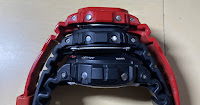Choosing Your Casio G-Shock: 5600 vs. 6900 and More
If you're diving into the world of Casio G-Shocks, you've likely encountered two iconic designs: the square 5600 series and the circular 6900 series. Both embody the durability, functionality, and iconic status of G-Shock watches. Here’s a breakdown to help you decide which model suits your needs best.
1. Form Factor (Size)
For those with smaller wrists, the compact, square 5600 series is often the better choice, while the larger, circular 6900 series tends to fit most wrist sizes comfortably. If you're new to G-Shock, it's a good idea to try both styles on to see which feels more comfortable.
2. Features (Modules)
Each G-Shock model comes with its own set of features. The entry-level DW models cover the essentials, including a timer, alarm, and stopwatch. On the other hand, higher-end models (like the GW or GLX series) offer advanced features such as solar charging, atomic time syncing, and world time. Consider what functionalities you’ll need for your lifestyle.
3. Style (Color and Design)
Choosing a style can be daunting, given Casio's plethora of limited editions and collaborations in various colors and designs. For a first G-Shock, I recommend starting with a classic black model—it's versatile and timeless. Once you have that, you can expand your collection with more vibrant colors or unique designs.
4. Materials (Plastic vs. Metal)
G-Shocks traditionally feature resin cases and straps, but Casio has introduced metal G-Shocks, which include stainless steel bezels and bracelets. These metal options not only add weight and durability but also give the watch a more premium feel. Both the 5600 and 6900 models are available in metal variants, providing the same ruggedness with added style.
Comparing Popular Models
A. DW-6900 vs. DW-5600
The DW-6900 and DW-5600 share similar core features, including a timer, alarm, and stopwatch. The main distinctions lie in size and button placement. The 6900 has a front-and-center light button that’s easy to activate, whereas the 5600's light button is positioned on the bottom right and can be slightly harder to press. Personally, I lean toward the DW-5600 for its lightweight feel and slim profile, making it easy to slide under a sleeve and perfect for daily wear.
B. DW-5600 vs. GLX-5600
If the GLX-5600 came in matte black, it would be my top choice! Unfortunately, I opted for a bright red GLX-5600, which doesn’t quite match my usual style but is great for beach or pool outings. The GLX-5600 offers extra features like world time and a tide indicator, plus its light button is conveniently located on the top right. However, I appreciate the DW-5600’s simpler button layout, which aids in timing tasks—especially important for my work involving time series tests. A major advantage of some higher-end “G” series models is the ability to disable the beeping sound, a feature absent in basic DW models.
Overall, I still prefer the DW-5600 for its versatile, classic appearance, but if the GLX-5600 were available in black, it would be an easy choice.
Looking Ahead: The Ideal G-Shock
If I were to start over, I’d likely choose a higher-end G-Shock from the 5600 series with Tough Solar and Atomic Clock Sync. This combination would give me my preferred form factor alongside top-tier features for an ultimate G-Shock experience.
Final Thoughts
You can’t go wrong with most G-Shock models—they're built to withstand a lot and are incredibly durable. If you're seeking a robust, stylish, and affordable watch, a G-Shock is essential. Almost everyone should have at least one in their collection for those days when a reliable “beater” watch is necessary.






Comments
Post a Comment